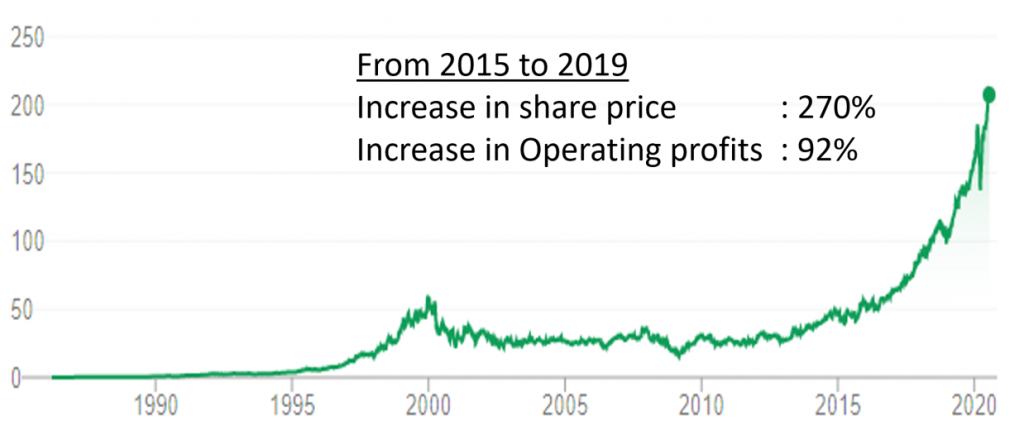Today, we will be focusing on the Valuation of Microsoft and my conclusion for whether you should buy Microsoft as this case study comes to a close. You might have missed out on the first 2 parts of the case study. As such, you can read Understanding Microsoft’s Business Model and Understanding Microsoft’s Management and Financials before you proceed for a more well-rounded understanding of the other factors I considered before deciding whether to invest into Microsoft.
The evolution of Valuation
Benjamin Graham, the father of value investing, used to buy companies and stocks based on Valuation. Valuation then could be easily calculated through looking at the financials of the company. If the company had a certain amount of assets and could be bought at a cheaper rate than what they had assets wise, it was an attractive buy.
Even Warren Buffett learnt from his mentor and used Valuation as a gauge of whether he should buy the company at the beginning of his career. However, as companies evolved, Warren Buffett too adapted his method of value investing. If you would like to read more about value investing, you can read: All you need to know about Stock Valuation.
However, today, I would place Valuation as the least important of my 4 tenets to consider before investing into the company. Valuation sets a boundary to observe to ensure that we do not pay a ridiculous price for the stock. However, it should not dictate whether we should or should not buy the stock.
Microsoft’s share price and operating profit

During the span of 2015 to 2019, Microsoft’s share price tripled while their operating profit only doubled. One would normally assume that the share price should follow the trend exhibited by the operating profit. So, why is there such a disconnect? I would surmise that this was the consequence of 2 reasons.
1. Investors are forward looking
Analysts in the investing world understand that the cloud-based business model has potential for even more revenue in the future. Furthermore, Microsoft’s subscription model allows analysts to make projections and make calculated guesses on more aspects of the company’s future.
2. The equity market is getting more expensive
The whole stock market is seeing a rise in the prices of stocks due to the current low interest rates. Even before the Corona virus, the world was already seeing the global economy head for a downturn. As such, the FED was already lowering the interest rates to support the economy. Subsequently, this encouraged people to borrow more money at a cheaper rate to invest in stocks. More money would mean more purchasing power to buy stocks. Hence, the higher demand for the stocks will lead to an increase in stock prices.
These 2 points are the reasons for the larger increase in share price in comparison to the operating profit. Although the lowest price of US$130 per share has past, should we still buy Microsoft’s share at this point?
Microsoft’s Valuation
Following my previous statement of Valuation being merely a boundary to observe to ensure that we do not pay an exorbitant amount for the share, I will generally not buy more than 3 times the price earnings growth ratio (PEG)[1].
The price earnings ratio (P/E ratio)[2] is 36 times and is quite steep in terms of what the normal investor is willing to pay. However, Microsoft has the potential for good quality growth, having been growing at a rate of more than 20% for the past few years. As such, if I reduce their future growth to a conservative estimate of 15% annually, it will still have a PEG ratio of 2.4 times, fitting nicely in my previously mentioned benchmark of 3 times.
What about the other factors?
Before we proceed to make a conclusion, we should look at the previous factors: Growth, Resilience, Management and Financials.
Microsoft’s Growth:
The cloud industry is growing fast and is in its initial growth stage. Microsoft is also getting market share within the cloud space and their profit margin[3] is expanding. With profit normally growing at a faster rate than revenue, profit should then grow quicker than 15% annually (revenue’s growth rate).
Microsoft’s Resilience:
Microsoft has high competitive advantage, high switching cost, an expansive network effect, recurrent income from their sticky business model and diversified revenue streams. As such, they are more resilient in the face of any external shocks that could happen to any one of their business segments.
Microsoft’s Management:
Leadership under Satya Nadella has continued to see long-term oriented management that is stable and innovative. Hence, under him, Microsoft seems to be heading in a positive direction.
Microsoft’s Financials:
Microsoft only past their inflection point around 2017 and 2018. Hence, Microsoft should continue to harness the momentum to go back to their old profit margin of 38-39%.
Should I buy Microsoft today?
Personally, I have bought Microsoft’s shares. Although it is no longer as cheap as before, we have no choice but to seize the moment and move forward with our investments.
However, Microsoft should only be a part of your overall asset allocation, with half of your portfolio being diversified with cash and gold as the economy is not the best now. Especially with the advent of the Coronavirus, economic growth might not shoot up as fast as the stock market and recovery could take much longer.
Hence, there should still be a portion of cash and gold (or safe haven[4] investments) so that you can easily pull out of the stock market if it goes south. However, we should keep some stocks as we do not want to stay at the side lines completely. As such, it is good to be partially invested into the right type of companies, with Microsoft being one of them.
Microsoft’s share price has grown about 900% since the last crisis. So, if we keep waiting for the opportunity to buy in at a low price, it might never happen. Looking back, even if we were to buy in at the wrong time and make a bit lesser, the small loss is nothing in comparison to the few hundred percent of returns. In sum, I would advise you to seize the opportunity you have now to purchase Microsoft.
[1] Price Earnings Growth Ratio (PEG ratio): (Price/Earnings per share [EPS]) / EPS Growth. It factors in both the stock’s value and the company’s expected earnings growth.
[2] Price To Earnings ratio (P/E ratio): Price for the share / Earnings per share. It indicates how much an investor is willing to pay for each dollar of earnings.
[3] Profit Margin: The ratio of the company’s profit divided by its revenue. It acts as an indicator of how well the company is handling its finances.
[4] Safe haven investments: An investment that can retain in value during times of economic downturn.
If you have any questions about your personal investment portfolio or want to learn how to better reap the opportunity you are now having, feel free to reach me via heb@thegreyrhino.sg or 8221 1200.
Remember to leave comments and share this site with your friends. Do subscribe to my newsletter for updates and share this site with your friends too. I would love to connect with you.

